light AUDI A8 2012 Workshop Manual
[x] Cancel search | Manufacturer: AUDI, Model Year: 2012, Model line: A8, Model: AUDI A8 2012Pages: 300, PDF Size: 75.06 MB
Page 87 of 300
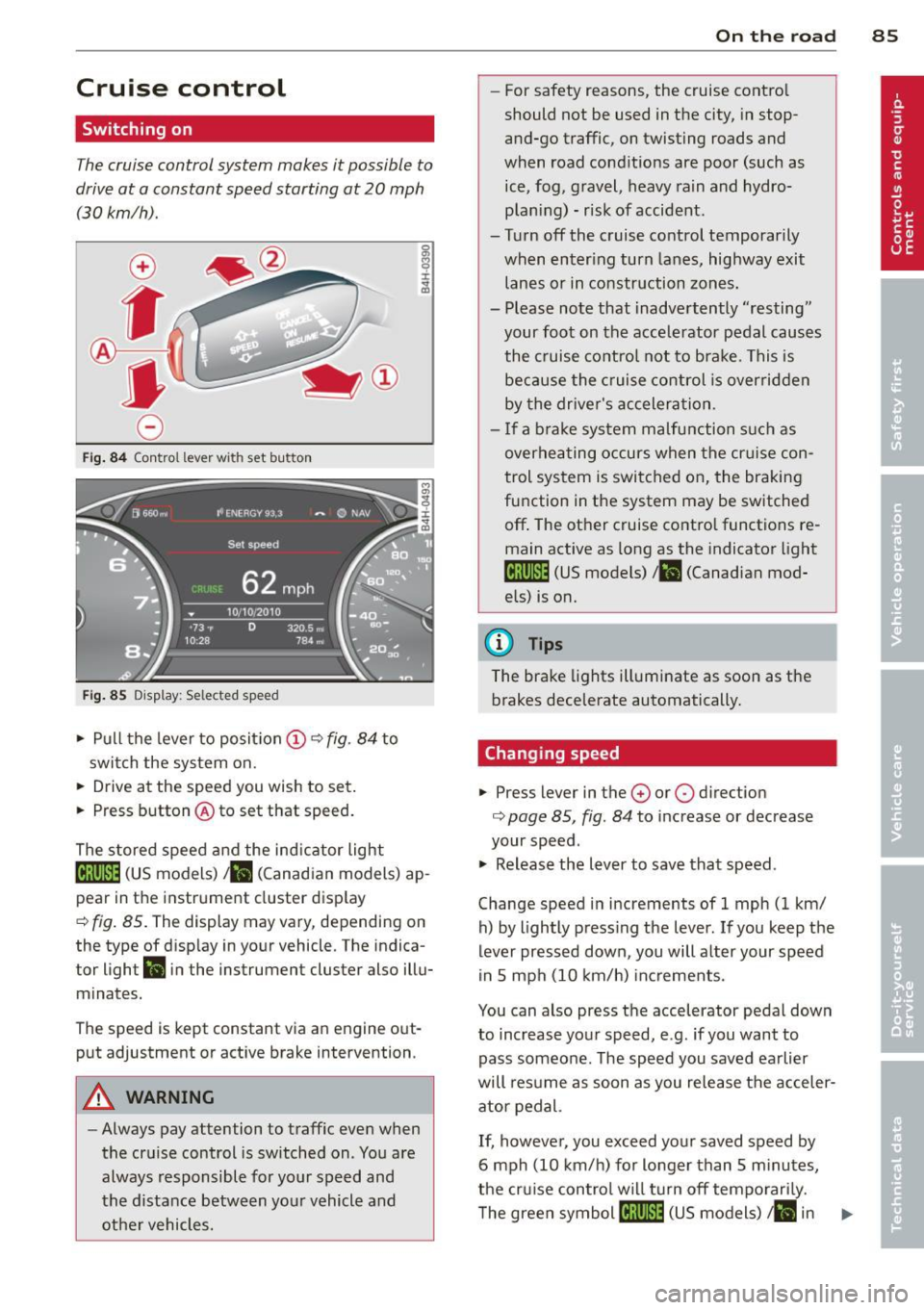
Cruise control
Switching on
The cruise control system makes it possible to
drive at a constant speed starting at 20 mph
(30 km/h).
0
f
~
0
Fig . 84 Control lever with set button
Fig . 85 D isplay: Selected speed
.,. Pull the lever to position (D ~ fig . 84 to
swit ch the system on .
.,. Drive at the speed you wish to set.
.,. Press button @to set that speed.
The stored speed and the ind icator light
[lj;(i)~1ij (US models) 1 11 (Canad ian models) ap
pear in the instrument cluster display
¢ fig. 85. The display may vary, depending on
the type of disp lay in your vehicle. The indica
tor light
Ill in the instrument cluster also illu
minates.
The speed is kept constant via an engine out
put adjustment or active brake intervention.
A WARNING
-Always pay attention to traffic even when
the cruise control is switched on . You are
always responsible for your speed and
the distance between your vehicle and other vehicles.
On the road 85
-For safety reasons, the cruise control
should not be used in the city, in stop
and-go traffic, on twisting roads and
when road conditions are poor (such as ice, fog, gravel, heavy rain and hydro
plan ing) - risk of accident .
- Turn off the cruise control temporarily
when enter ing turn lanes, highway exit
lanes or in construction zones.
- Please note that inadvertently ''resting"
your foot on the accelerator pedal causes
the cruise control not to brake. This is
because the cruise control is overridden
by the driver's acceleration .
- If a brake system malfunction such as
overheating occurs when the cr uise con
trol system is switched on, the braking
function in the system may be switched
off . The other cruise contro l functions re
main active as long as the indicator light
tij;[i)~1ij (US models) 111 (Canadian mod
els) is on.
(D Tips
The brake lights illuminate as soon as the brakes decelerate automatically.
Changing speed
.,. Press lever in the 0 or 0 direction
¢ page 85, fig . 84 to increase or decrease
your speed .
.,. Release the lever to save that speed.
Change speed in increments of 1 mph (1 km/ h) by lightly press ing the lever. If you keep the
lever pressed down , you will alter your speed
in 5 mph (10 km/h) increments.
You can also press the accelerator pedal down
to increase your speed, e.g. if you want to
pass someone. The speed you saved earlier
will resume as soon as you release the acceler
ator pedal.
If, however, you exceed your saved speed by
6 mph (10 km/h) for longer than 5 m inutes,
the cruise control wil l turn off temporarily.
The green symbol
[ljlIJll (US models) ill in ..,_
Page 92 of 300
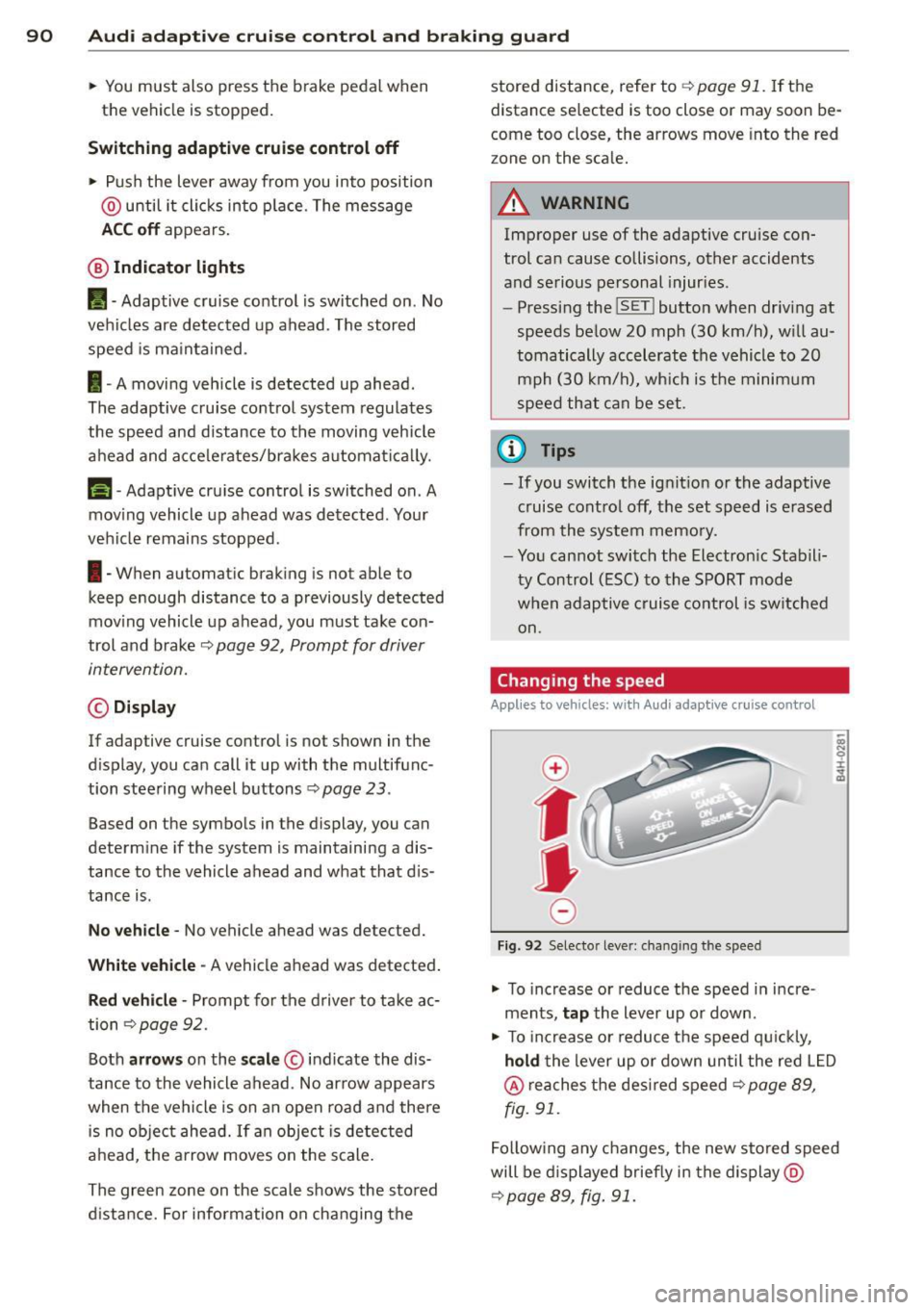
90 Audi adaptive cruise control and braking guard
• You must also press the brake pedal when
the vehicle is stopped.
Switching adaptive cruise control off
• Push the lever away from you into position
@ until it clicks into p lace. The message
ACC off appears.
@ Indicator lights
II-Adaptive cruise control is switched on . No
vehicles are detected up ahead. The stored
speed is maintained.
I-A moving vehicle is detected up ahead .
The adaptive cruise control system regulates
the speed and d istance to the moving vehicle
ahead and acce lerates/bra kes automatica lly.
f§ . Adaptive cru ise control is switched on . A
mov ing vehicle up ahead was detected. Your
vehicle remains stopped .
I -When automatic braking is not able to
keep enough distance to a p reviously detected
mov ing vehicle up ahead, you must take con
trol and brake¢
page 92, Prompt for driver
intervention.
© Display
If adap tive cruise control is not shown in the
d isplay, you can call it up with the multifunc
tion steering wheel buttons~
page 23.
Based on the symbols in the display , you can
determ ine if the system is maintaining a dis
tance to the vehicle ahead and w hat that dis
tance is.
No vehicle -No vehicle ahead was detected.
White vehicle -A vehicle ahead was detected .
Red vehicle -Prompt for the driver to take ac
tion ¢
page 92.
Both
arrows on the scale © indicate the dis
tance to the vehicle ahead . No arrow appears
when the vehicle is on an open road and there is no object ahead. If an object is detected
ahead, the arrow moves on the scale.
The green zone on the scale shows the stored d istance. For information on changing the stored distance, refer to
¢
page 91. If the
distance se lected is too close or may soon be
come too close, the arrows move into the red
z one on the sca le.
A WARNING
Improper use of the adaptive cruise con
trol can cause collisions, other accidents
and serious personal injur ies .
- Pressing the
!SET ! button when driving at
speeds below 20 mph (30 km/h), w ill au
tomatically accelerate the vehicle to 20
mph (30 km/h), which is the minimum
speed that can be set .
(D Tips
-If you switch the ignit ion or the adaptive
cruise control off, the set speed is erased
from the system memory.
- You cannot switch the Electron ic Stabili
ty Control (ESC) to the SPORT mode
when adaptive cruise control is switched
on .
Changing the speed
Applies to vehicles: with Audi adaptive cru ise control
0
f
• 0
Fig. 92 Selecto r lever : chang ing t he spee d
• To increase or reduce the speed in incre
ments,
tap the lever up or down.
-
-a)
N
q :r
~
"' To increase or reduce the speed qu ickly,
hold the lever up or down until the red L ED
@ reaches the desired speed ¢ page 89,
fig . 91.
Following any changes, the new stored speed
will be displayed briefly in the display @
¢page 89, fig. 91.
Page 94 of 300
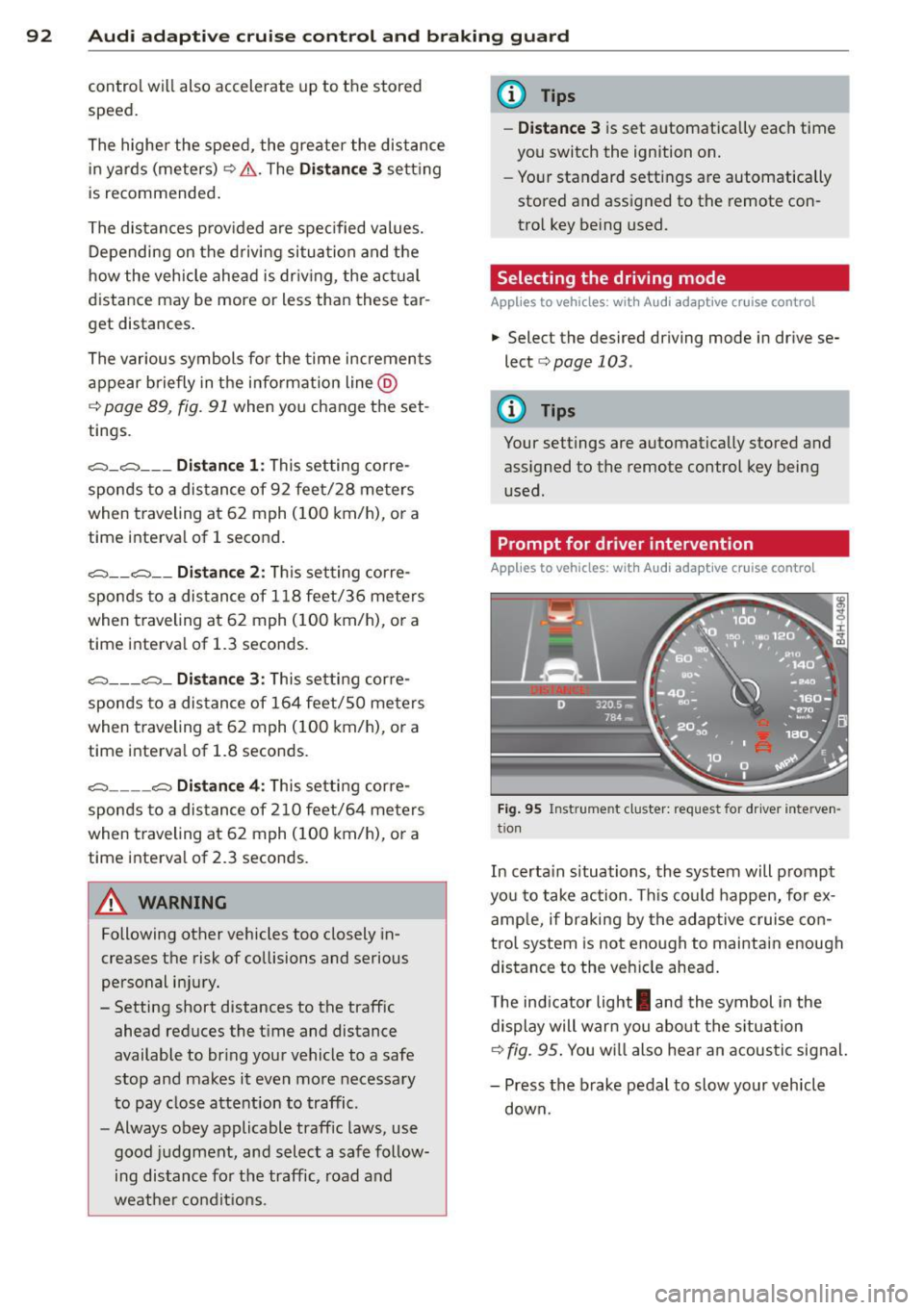
92 Audi adaptive cruise control and braking guard
control will also accelerate up to the stored
speed.
The higher the speed , the greater the distance
in yards (meters)¢ .&.. T he
Distance 3 setting
is recommended .
The distances p rov ided are spec ified values.
Depending on the driving situation and the
how the vehicle ahead is dr iving, the actual
distance may be more or less than these tar
get distances .
The various symbols for the time increments
appear briefly in the info rmation line @
¢ page
89, fig. 91 when you change the set
tings .
c:::,_c:::, ___ Distance 1: This setting corre-
sponds to a distance of 92 feet/28 meters
when traveling at 62 mph ( 100 km/h), or a
time interval of
1 second.
c:::, __ c:::, __ Distan ce 2: Thi s setting corre
sponds to a dis tance of 118 feet/36 meters
when traveling at 62 mph ( 100 km/h), or a
time interva l of 1.3 seconds.
c:::, ___ c:::,_ Distance 3: This setting corre-
sponds to a distance of 164 feet/SO meters
when traveling at 62 mph ( 100 km/h), or a
time interva l of 1.8 seconds.
c:::, ____ c:::, Distance 4: This setting corre-
sponds to a distance of 210 feet/64 meters
when traveling at 62 mph ( 100 km/h), or a
time interval of 2.3 seconds.
.&_ WARNING
Following other vehicles too closely in
creases the risk of collisions and serious
personal injury.
- Setting short distances to the traffic ahead reduces the t ime and distance
available to br ing your vehicle to a safe
stop and makes it even more necessary
to pay close attention to traffic.
- Always obey applicable traffic laws, use
good judgment, and select a safe follow
ing distance for the traffic, road and
weather conditions .
(D Tips
-Distance 3 is set automatically each time
you switch the ignition on.
- Your standard settings are automatically
stored and assigned to the remote con
tro l key being used.
Selecting the driving mode
Applies to veh icles: w ith Audi adapt ive cr uise contro l
.,. Select the desired driving mode in dr ive se
lect
¢ page 103 .
@ Tips
Your settings are automatically stored and
assigned to the remote control key being
used.
Prompt for driver intervention
Applies to vehicles : w it h Audi ada ptive cr uise cont ro l
Fig. 95 Instrument cluster: request for driver inte rven
tio n
In certa in s ituations, the system will prompt
yo u to take action . Thi s could happen, for ex
amp le, if braking by the adaptive cruise con
trol system is not enough to maintain enough
distance to the veh icle ahead .
The indicator light
I and the symbol in the
display will warn you about the situa tion
¢fig.
95. You w ill also hear an acoustic signal.
- Press the brake pedal to slow your vehicle
down.
Page 95 of 300

Audi adaptive cruise control and braking guard 93
Audi braking guard
Description
Applies to vehicles: with Audi adaptive cruise control
Fig. 96 Instrument cluster: approach warning
Audi braking guard uses radar sensors and a
video camera. It also functions within the lim
its of the system when adaptive cruise control
is switched off.
What can Audi braking guard do?
When detected in time, the system can assess
situations when a vehicle ahead brakes sud
denly or if your own vehicle is traveling at a
high speed and approaching a vehicle up
ahead that is moving more slowly . Audi brak
ing guard does not react if it cannot detect
the situation.
The system advises you of various situations:
- The
distance warning is given if you are too
close to the vehicle ahead for a long time. If
the vehicle ahead brakes sharply, you will not be able to avoid a collis ion. The indicator
light
I i n the display comes on .
- The
approach warning is given when a de
tected vehicle up ahead in your lane is mov
i ng much more slowly than you are or if it
brakes sharply . When this warning is given,
it may only be possible to avoid a collision
by swerving or braking sharply. The indicator
light
I and indicator in the display will warn
you about the danger
c::> fig . 96. You will a lso
hear an acoustic signal.
If you do not react fast enough or do not react
at all to the situation, Aud i braking guard will
11
This is not ava ilable in som e coun tri es.
intervene by braking and the message braking
guard intervention
will appear.
- If a coll is ion is imminent, the system wi ll
first provide an
acute warning by briefly and
sharply applying the brakes.
- If you do not react to the acute warning,
braking guard can brake with increas ing
force within the limits of the system. This
reduces the vehicle speed in the event of a
collision.
- The system can initiate complete dece lera
tion shortly before a collision
1>. Full deceler
ation at high speeds occurs only in vehicles
with adaptive cruise control and side assist
(pre sense plus).
- If the Audi braking guard senses that you
are not braking hard enough when a colli
sion is immi nent, it can increase the braking
force.
- The pre sense functions also engage when a
collision is imm inent
c::> page 185 .
Which function s can be controlled?
You can switch Audi braking guard and the
distance/approach warning on or off in the
MMI c::> page 94, Settings in the MMI.
A WARNING
Lack of attention can cause collisions, oth
er accidents and serious personal injuries .
The Audi braking guard is an assist system
and cannot prevent a collision by itself.
The driver must always intervene. The driv
er is always responsib le for braking at the
correct time.
- Always pay close attention to traffic,
even when the Audi braking guard is
switched on. Be ready to intervene and
be ready to take complete control when
ever necessary. Always keep the safe and
legal distance between your veh icle and
veh icles up ahead.
- Audi brak ing guard works within limits
and will not respond outside the system
lim its, for example when approaching a
Page 98 of 300
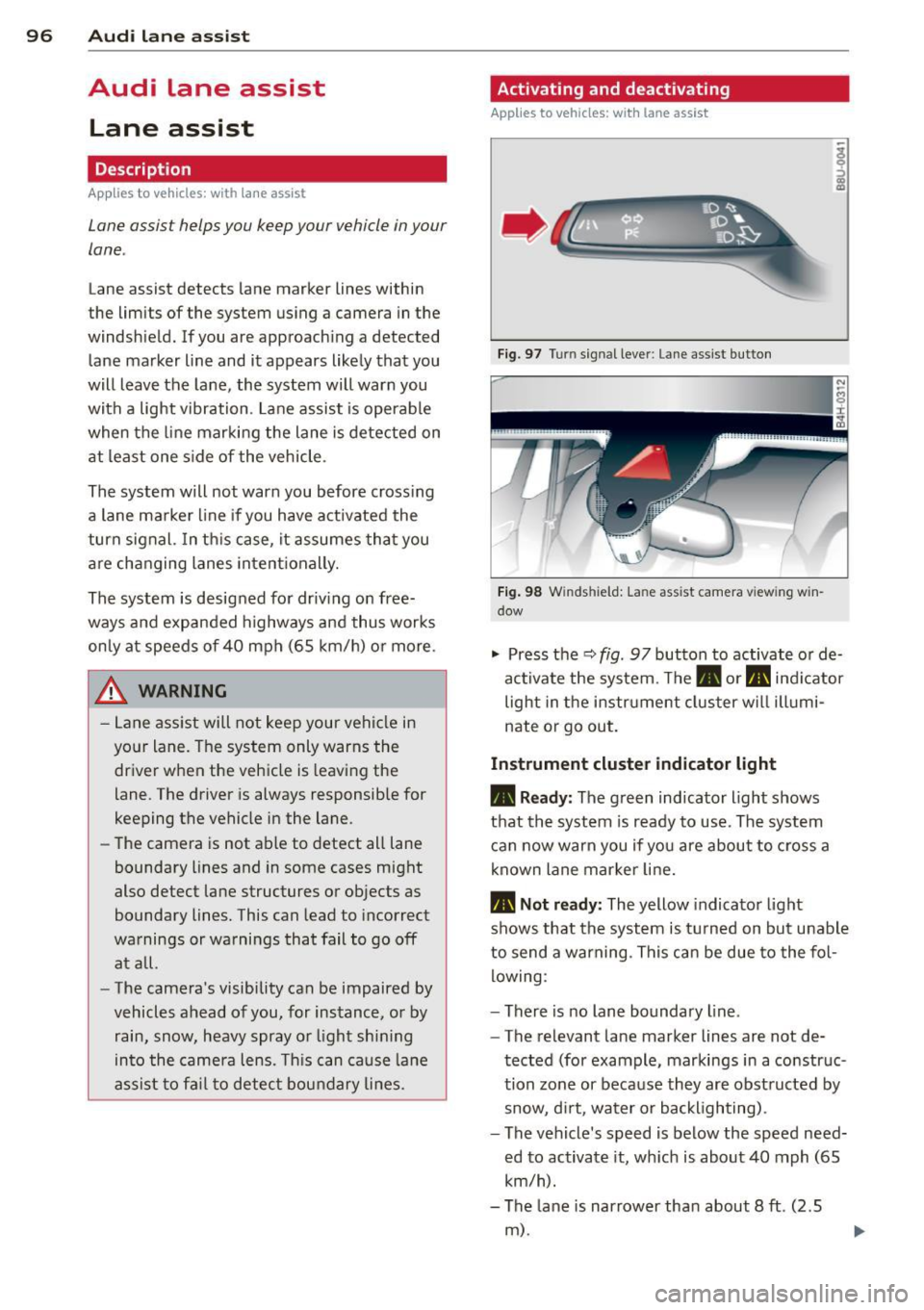
96 Audi la ne a ssis t
Audi lane assist
Lane assist
Description
Appl ies to vehicles: with lane assist
Lane assist helps you keep your vehicle in your
lane .
Lane assist detects lane marker lines within
the limits of the system using a camera in the
windshield. If you are approaching a detected
lane marker line and it appears likely that you
will leave the lane, the system will warn you
with a light vibration . Lane assist is operable
when the line marki ng the lane is detected on
at least one s ide of the vehicle .
The system will not warn you before cross ing
a lane ma rker line if you have activated the
turn signal. In t his case, it assumes tha t you
a re cha nging lanes intent ionally.
The system is designed for driv ing on free
ways and expanded highways and thus works
on ly at speeds of 40 mph (65 km/h) o r more .
.&_ WARNING
-Lane ass ist will not keep your vehi cle in
yo ur lane. The system only warns the
dr iver w hen the vehicle is leaving the
lane . The driver is always responsib le for
keeping the vehicle in the lane .
- The camera is not able to detect all lane
boundary lines and in some cases might
also detect lane structures or objects as
boundary lines. This can lead to incorrect
warnings or warnings that fail to go off
at all .
- The camera's visibility can be impaired by
vehicles ahead of you, for instance, or by
rain, snow, heavy spray or light shin ing
in to the camera lens. This can cause lane
a ssist to fa il to detec t bou ndary lines.
- Activating and deactivating
Applies to
vehicles: with lane assist
Fig. 9 7 Turn signal lever: Lane-ass ist button
Fig . 98 W ind shi eld: Lane assist camera viewing win
dow
"' Press the q fig . 97 button to activate or de
activate the system. The. or. indicator
light in the instr ument cluster w ill illumi
nate or go out.
Instrument cluster indicator light
• Ready : The green indicator light shows
that th e system is ready to use . Th e system
can now warn you if yo u are about to cross a
known lane mar ker line.
• Not r ead y: The yellow indicator light
shows that the system is t urned on bu t unable
to send a warning . This can be due to the fol
lowing :
- There is no lane boundary line .
- The relevant lane marker lines are not de-
tected (for example, markings in a construc
tion zone or because they are obst ructed by
snow, d irt, water or backlighting) .
- The vehicle's speed is below the speed need·
ed to activate it, wh ich is about 40 mph (65
km/h).
- The lane is narrower than about 8
ft . (2.5
m) .
Page 100 of 300

98 Audi lane assist
Setting the warning point and steering
wheel vibration
Applies to vehicles: with lane assist
You can adjust individual settings in the MMI.
.. Se lect: ICARI funct ion button> Car systems
control button > Driver assist > Audi lane
assist .
Setting the warning point
Early: With this setting, a warning is provided
before a wheel touches the detected lane
boundary line . The warning depends on the
angle in which the veh icle is approaching the
line. The distance at which the warning is giv
en increases as the angle becomes sharper. If
you dr ive towa rd a bounda ry line at a very
sha rp angle, the warning will come just before
a wheel touches the line.
Medium : With this setti ng, the warn ing po int
is adapted to the course of the road, the lane
width and the speed. You wi ll sti ll be warned
if you cross slightly over a dotted line when
driving on curves.
Late : This setting has the same properties as
medium. You will only be warned once a
wheel crosses a detected line.
Setting the steering wheel vibration
The steering wheel v ibration can be set to
Low , Medium or Strong . Selecting each of the
settings will cause the steering wheel to vi
b rate so you can check the strength of the vi
bration in that setting.
(D Tips
Your settings are automatically stored and
assigned to the remote contro l key being
used .
Page 105 of 300
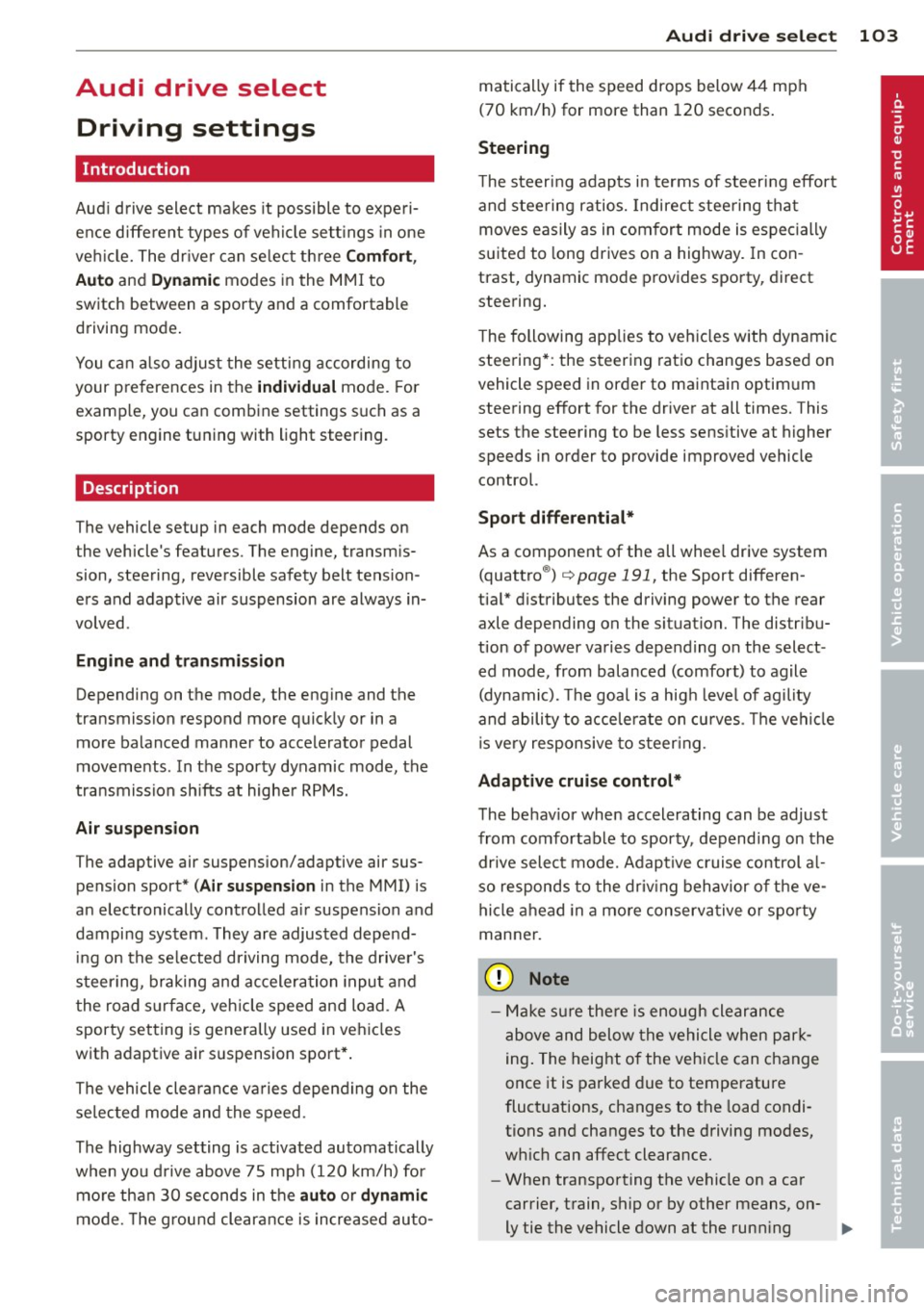
Audi drive select Driving settings
Introduction
Aud i drive select makes it possible to experi
ence different types of vehicle settings in one
veh icle. The driver can select th ree
Comfort,
Auto
and Dynamic modes in the MMI to
switch between a sporty and a comfortable
driving mode.
You can also adjust the setting according to
your preferences in the
individual mode. For
examp le, you can combine settings such as a
sporty engine tuning with light steering.
Descript ion
The vehicle setup in each mode depends on
the vehicle's features. The engine, transmis
sion, steering, reversible safety belt tension
ers and adaptive air suspension are always in
volved .
Engine and transmission
Depending on the mode, the engine and the
transmission respond more quickly or in a
more balanced manner to accelerator pedal
movements. In the sporty dynamic mode, the
transmission sh ifts at higher RPMs.
Air suspension
The adaptive air suspension/adaptive air sus
pension sport*
( Air suspension in the MMI) is
an electronically cont rolled air suspension and
damping system. They are adjusted depend ing on the selected driving mode, the driver's
steering, braking and acceleration input and
the road s urface, veh icle speed and load. A
sporty setting is generally used in vehicles
with adaptive air suspension sport *.
The vehicle clearance va ries depending on the
selected mode and the speed .
The highway setting is activated automatically
when you drive above 75 mph (120 km/h) for
mo re than 30 seconds in the
auto or dynamic
mode. The g round clearance is increased auto-
Audi drive select 103
matically if the speed drops below 44 mph
(70 km/h) for more than 120 seconds.
Steering
The steering adapts in terms of steering effort
and steering ratios. Indirect steering that
moves easily as in comfort mode is especially
s ui ted to long drives on a highway. In con
trast, dynamic mode provides sporty, direct
steering.
T he following applies to vehicles with dynamic
steering*: the steering ratio changes based on
vehicle speed in order to maintain optimum
steering effort for the driver at all times. This
sets the steering to be less sens itive at higher
speeds in order to provide improved vehicle
control.
Sport diffe rential*
As a component of the all whee l drive system
(quattro
® ) c> page 191, the Sport differen
tial* distributes the driving power to the rear
axle depending on the situat ion. The dis tribu
tion of power varies depending on the select
ed mode, from balanced (comfort) to agile
(dynamic). The goal is a hig h level of agility
and ability to accelerate on curves. Th e vehi cle
is very responsive to steer ing.
Adaptive cruise control*
The behav ior when accelerating can be adjust
from comfortable to sporty, depending on the
drive select mode. Adaptive cruise control al
so responds to the driving behavior of the ve
hicle ahead in a more conserva tive or sporty
manner.
(D Note
- Make sure there is enough clearance
above and below the vehicle when park
ing . The height of the vehicle can change
once it is parked due to temperature
fluctuations, changes to the load condi
tions and changes to the driving modes,
w hich can affect clearance.
- When transporting the vehicle on a car
carrier, train, ship or by other means, on-
ly tie the vehicle down at the running
IJJ,,
Page 107 of 300
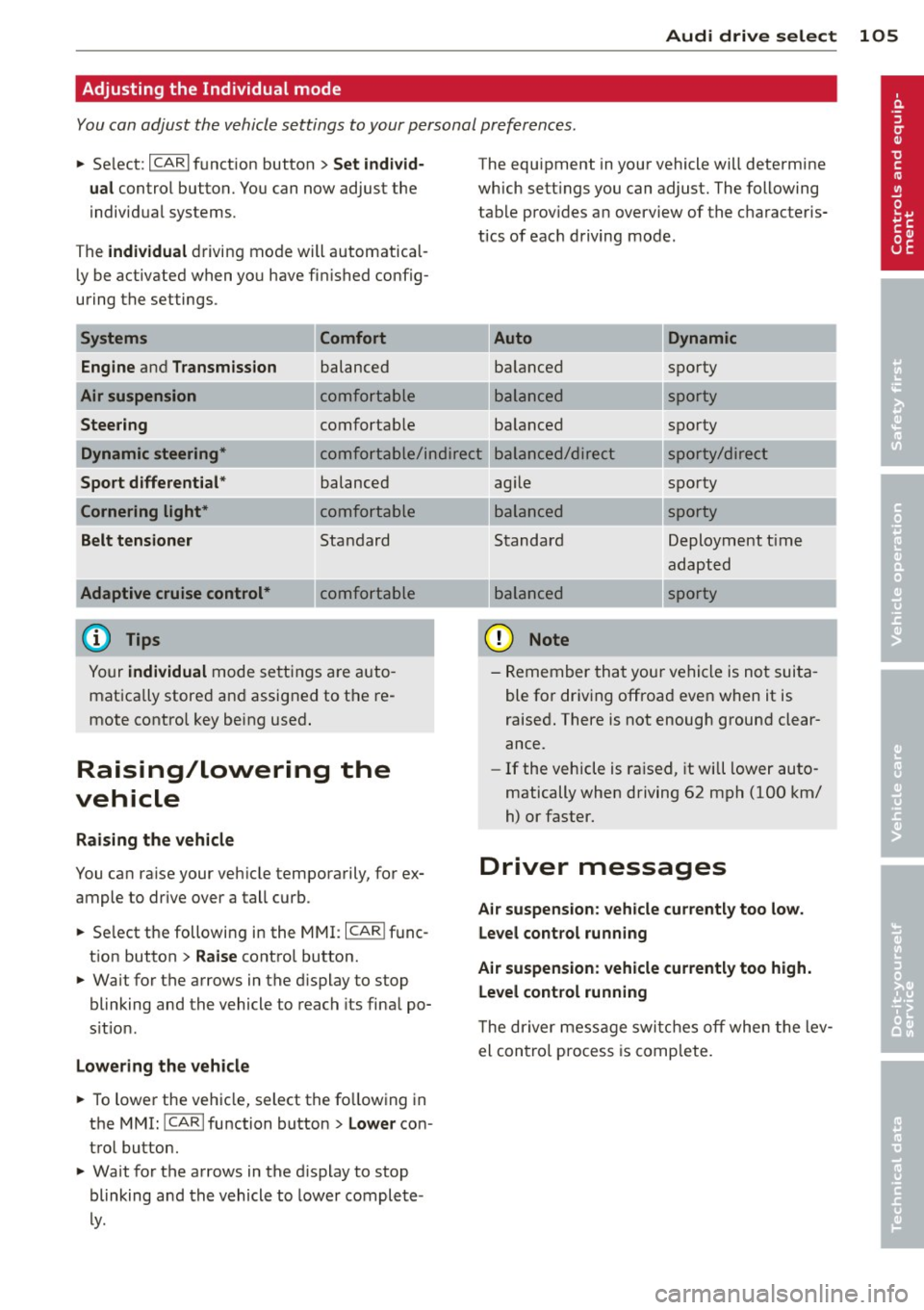
Audi drive select 105
Adjusting the Individual mode
You can adjust the vehicle settings to your personal preferences.
~ Select: ICARlf unct ion button> Set individ·
ual
control button. You can now adjust the
individua l systems.
The
individual d riving mode will automatical
l y be activated when yo u have fin ished config
uring the settings.
Systems
Engine
a nd Transmission
Air suspension Steer ing Comfort balanced
comfo
rtable
comfortab le The equ
ipment in your vehicle will determ ine
which sett ings you can adjust. The following
tab le prov ides a n overview of the c haracteris
tics of eac h driving mode.
Dynamic
ba lanced spo
rty
---.. ,
s porty
ba lanced spo
rty
Dynamic steering*
Sport differential *
Cornering light*
Belt tensioner c o mfo rtable/ind ire c t balanced/dire ct sporty/direc t
spo rty
Adaptive cruise control *
balanced
comfortable
Standard
comfo rtable
Yo ur
individual mode se ttings a re auto
mat ica lly store d an d assig ned to t he re
mote control key bein g use d.
Raising/lowering the
vehicle
Raising the vehicle
You ca n ra ise your veh icle temporarily, for ex
ample to drive over a tall curb.
~ Se lect the following i n the MMI: I CARI f unc
t ion button >
Raise control button.
~ Wait for the arrows in the d isplay to stop
blinking and the vehicle to reach its fina l po
s it io n.
Lowe ring the vehicle
~ T o lower the veh icle, select the fo llow ing in
the MMI: ICARlfunction button>
Lower con
trol button.
~ Wa it for the arrows in the d isplay to stop
blinking and th e vehicle to lower complete
ly . ag
ile
balanced
Standard
balanced
(D Note
---.. ,
---.. ,
sporty Deployment t ime
adapt ed
sporty
- Remember that your ve hicle is not sui ta
ble fo r dr iv ing offroa d even when it is
raised . There is not enough ground clear
ance.
- If the vehicle is ra ised, it will lower auto
matically when driving 62 mph (100 km/
h) or faster.
Driver messages
Air suspension : vehicle currently too low.
Le vel control running
Air suspension: vehicle currently too high. Level control running
T he dr iver mess age swi tches o ff when the lev
el con tro l process is comp lete.
Page 108 of 300

106 Night vision assistant
Night vision assistant
Description
Applies to vehicles: with night v isio n ass istant
Fig. 107 Display: n ight vis ion assistant
"Night vis ion assistant with pedestrian detec
tion" uses an infrared camera to monitor the
area in front of you r vehicle at night. Within
the limits of the system, it can display objects
up to about 1000 feet (300 meters) away. The
heat image of a pedestrian detected by the
camera is shown in the instrument cluster dis
p lay ¢
fig. 107. Warm areas appear lighter
and cold areas appear darker.
Pedestrian detection
Applies to vehicles: with nig ht v isio n ass istant
Fig. 108 Display: yellow pedestr ian marking
Fig . 109 D isplay: symbol when infrared image is not
visib le
Night vision assistant can detect pedestrians
that are between about 50 and 300 feet (15
and 90 meters) in front of the vehicle, under
ideal conditions.
If a pedestr ian is detected
when it is dark outside and the vehicle head
lights are switched on, the pedestrian is high
lighted in yellow¢
fig. 108, ¢ page 107,
General information. If another display such
as navigation replaces the image from the
night vision assistant, the symbol
~11 appea rs
in a tab
¢fig . 109.
(D Tips
If the night vision assistant image does
not appear when the system is switched
on, you can access it with the buttons on
the multifunction steering wheel
¢pa ge 24.
Pedestrian warning
Applies to vehicles: wit h night vision assistant
Fig. 110 D isp lay: pedestrian warning
Fig . 111 D isp lay: pedestr ian warning w ith another dis
play
If a pedestr ian is detected in an area in fron t
of the vehicle that the system considers criti
ca l, the pedestrian is highlighted in red
¢fig . 110 and a warning tone sounds. This
area is based on the vehicle speed and
Page 109 of 300

steering angle. The pedestrian warning prompts you to pay even closer attention to
the area in front of the vehicle and to watch
out for pedestrians.
I f another display such as the trip comp uter
replaces the image from the night vision as
sistant, the indicator light turns red when
there is a pedestrian warn ing
I Q fig. 111.
@ Tips
The pedestrian marking and warning tone can be adjusted in the MMI
¢ page 108.
General information
Applies to vehicles: with night vision assistant
N 0
8 :i:
~
Fig. 112 Front of the vehicle: night vision assistant
camera
The following situations may affect the func
tion of the night vision assistant system:
- poor v is ibility such as snow, rain, fog or
heavy road spray
- dirty lens on the night vision assistant cam- era
Make sure the n ight v ision assistant camera
i::> fig. 112 is not cove red by stickers, deposits
or any other obstruct ions because that can
prevent the camera from working properly.
F or information on cleaning the lens, refer to
¢page 205.
P edestrian detection depends on the differ
ence in temperat ure between the person and
the background. Pedestrians may not be de
tected if the temperature difference is too
small. The pedestrian highlighting feature is
deactivated at temperatures above 77 °F (25
0
() and when it is light outside.
N ig ht visi on ass is ta n t 107
A WARNING
Night vision ass istant has limits and can
not always detect pedestr ians . Always pay
close attention to traffic and the area
around your vehicle even when night vision
assistant is sw itched on.
- Night vision assistant can only warn
about people located within the visual
range of the infrared camera. The vis ual
range corresponds to the image in t he in
strument cluster display.
- Night vision assistant may not detect
peop le and highlight them if
- they are not in an upright posit ion, for
example if they are sitt ing, crouching
or lying down and/or
- if the outline in the display is incom
plete or interrupted, for example be
cause the person is part ially hidden by
a parked vehicle .
@ Tips
- Pedestrian detection and the pedestrian
warm ing a re limited to objects that are
detected as pedestrians. The system
does not detect an imals. Even though
the shape and warmth radiated by each
object detected is evaluated, the system
does have limitat ions and it can give in
correct warnings .
- For technical reasons, the image pauses
in split second intervals.
Switching on and off
Applies to vehicles: with night vision assistant
F ig. 113 Area around the light switch: night v is ion as-
s ista nt button .,.